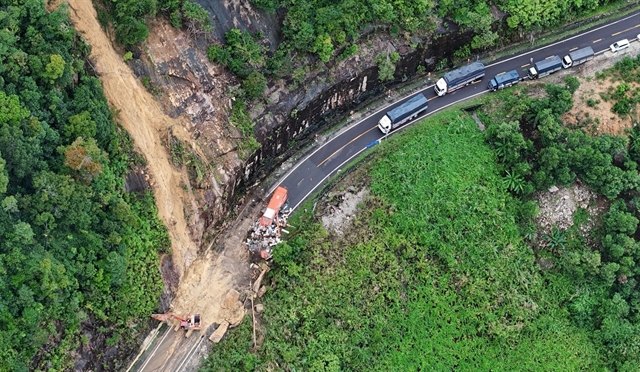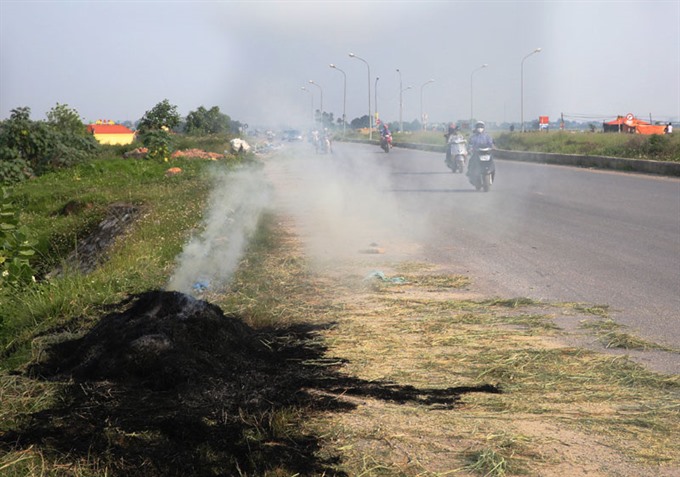 Environment
Environment

As Hà Nội farmers have finished harvesting rice, people living in suburban areas have complained about the smoke in the air caused by the burning of straw fields.
 |
| Straw is burned on a field in Mỹ Hưng Commune, Thanh Oai District in Hà Nội. — Photo hanoimoi.com.vn |
HÀ NỘI — As Hà Nội farmers have finished harvesting rice, people living in suburban areas have complained about the smoke in the air caused by the burning of straw fields.
The post-harvest practice has long been common and this year is no different, causing annoyance for citizens.
According to the city’s Department of Natural Resources and Environment, farms in the city generate more than one million tonnes of agricultural waste yearly including 642,000 tonnes of straw, 171,000 tonnes of husk, 204,000 tonnes of corn stalks/leaves and 68,000 tonnes of cob.
More than 36 per cent of agricultural waste in the city is burned. In suburban districts, the rate is 90 per cent in Đan Phượng District, 70 per cent in Mê Linh, 69 per cent in Hoài Đức and 60 per cent in Gia Lâm. Rice farming occurs in 20 suburban districts, two thirds of the city’s total districts.
A farmer named Minh in Sủi Village, Đặng Xá Commune, Gia Lâm District told Kinh tế & Đô thị (Econmic and Urban Affairs) newspaper that after harvesting time, her whole village suffered from smoke due to straw burning.
“We know that burning straw is not good for human health and the environment but we don’t know what to do with the straw except for burning it,” Minh said.
“The burned straw could be used as fertiliser for the next crop and the burning happens quickly,” she said.
Đặng Mão, a resident of an apartment building in Đặng Xá Commune said her family lived there for six years and they had to breathe the smoky air twice a year.
“At about 5-7 o’clock in the afternoon in summer, dense smoke rushes into our apartment. It feels very unpleasant,” Mão said.
“Kids cough and adults can do nothing but close all the windows and doors,” she added.
Trọng Thái, a taxi driver who usually drives to and from Nội Bài Airport said that after he crossed Thăng Long Bridge, his vision was narrowed due to smoke.
“It’s dangerous and threatens road safety, especially during bad weather,” Thái said.
According to Professor of Biology Nguyễn Lân Dũng, after being burned, organic matter in straw turns into non-organic material that dries the soil.
The ash containing little phosphate, Kali, calcium and silicon was not useful for the soil.
“A hectare of rice produces about 10-12 tonnes of straw. Burning thousands of tonnes of straw yearly could produce a huge volume of greenhouse gases that pollutes the air and harms human health,” he said.
Mai Trọng Thái, head of the city’s Environment Protection Division under the Environment Department, said that burning straw continued because of farmers understanding.
Straw burners were not fined because it was not banned, he said.
Thái said straw could be used to grow mushrooms or animal feed but mushroom/animal feed producers wanted the straw to be wrapped tight and transported to their facilities.
“The city is seeking solutions to curb straw burning and end the bad habit by 2020,” Thái said.
Last year, the city’s Environment Department and its partners launched a campaign ‘Don’t burn Straw’ to raise awareness among farmers about the harmful effects of burning straw and to present options for the recycling and reuse of straw.
The campaign is expected to improve economic efficiency, and to protect the environment and public health. Farmers will be provided guidance on composting straw residue to create organic fertilizer or to use it for animal feed and mushroom cultivation.
Thái said that early this year, Đông Anh and Đan Phượng Districts were selected to implement a pilot programme on using biological products to process straw to make organic fertiliser.
He said that under the campaign, straw would be collected and recycled to make playgrounds for children. — VNS




